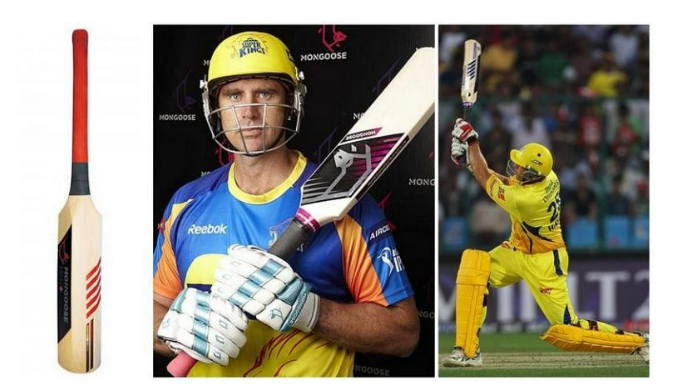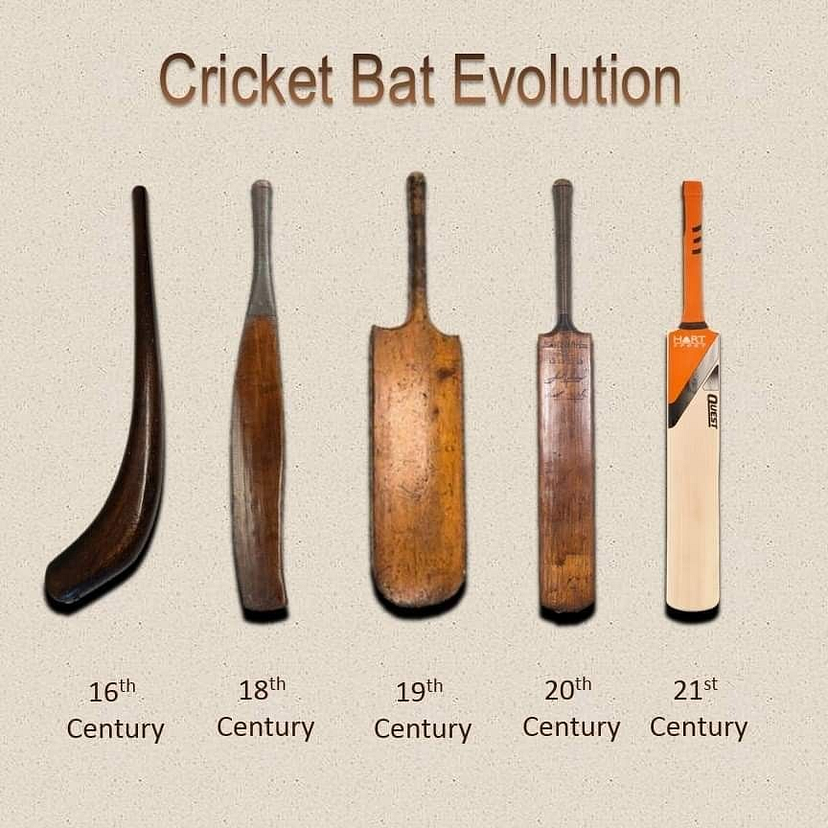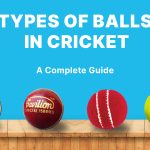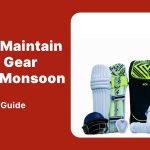Former Australian opener Matthew Hayden took the cricket world by storm in the 2010 IPL third season. But what was so unusual?
The use of the unheard and controversial Mongoose bat.
First, how many of you can recall the electrifying performance from the 2010 IPL match?
Let’s help you recall better–Mathew Hayden created history by using the Mongoose bat for Chennai Super Kings against Delhi Daredevils (now Delhi Capitals). He retired after scoring a smashing 93 off 43 balls. As per media records, he hit nine fours and seven sixes in that match.
The bat used by Hayden decreased the striking surface area and boosted the effect of the bottom hand. This sensational match created a bunch of speculation and invited expected criticism.
As funny as it sounds, Former Australian Test Player, Stuart Law called it a “half-brick-on-a-stick”.
Do you see the same?

Hayden’s debut in the IPL with this new weapon of choice was about to revolutionize the batting format. However, since its introduction, the usage of this bat diminished and did not create another success story.
Before we unravel why the usage of this bat diminished,let’s start with understanding the technicalities of the bat.
What is a Mongoose Bat?
The long handle-short blade bat popularized by Australian legend Mathew Hayden was first created by Mongoose– a British company that launched this controversial bat under the name ‘MMi3’.
Mongoose bat for cricket players is yet another innovation that enabled the batter to smack sixes and power shots in a short format game. The lightweight stout-framed and long-handled bat rose to glory with IPL and T20 but soon got criticized for the defensive strokes.
Evidently, the Mongoose cricket bat is quite different from a conventional bat. Because of the long handle, a batter could exert more power and handle elevations.
The strong frame offered the perfect opportunity for a batter to pull off boundaries and easily hit the perfect sixes, making it suitable for short-formats of the game such as T20.
Apart from the frame and structure, the bat manufacturer paid extra attention to the grip. A strong grip meant attacking mode for the batters and miss-hits flying off the boundary.
What is the specialty of the Mongoose bat?
We are sure the hype and news have left you wondering what makes this bat so special?
The legendary piece of work caught the attention of the world during a famous IPL match between Chennai Super Kings and Delhi Daredevils (now Delhi Capitals).
If Mathew Hayden’s attempt in the IPL was any noteworthy, why hasn’t the bat been normalized as much as the English Willow cricket bat?
Let’s spill the beans–a Mongoose bat is not a bat for the novice.
It’s definitely a tough nut to crack!
This cricket bat is an upgraded version of the traditional bat but designed for the T20 format of games. The weight taken away from the upper segment of the bat is redistributed to the remaining half of the bat. With a little precision, the batter can make a call for an aggressive shot at the last moment and change it in an instant.
Considering the bat isn’t an ordinary one, it requires expertise and experience. In an article published in the TOI, they mention a time when Dhoni was skeptical and discouraged Hayden from using the Mongoose bat. Hayden reassured Dhoni, “I have been using this bat for practice for about a year and a half and when it hits the middle of the bat it goes 20 meters further.”
That definitely reassured Dhoni that Mongoose cricket bat isn’t a bat for the layman and demands practice as well as solves the mystery of the Mongoose bat’s speciality.
Mongoose bat vs Normal bat: Is one cricket bat different from the other?
It’s well-stated and absorbed that the mongoose bat isn’t an ordinary bat and clearly not for the common man.
But how do you know the bat you own is or isn’t a mongoose bat?
Let’s discuss a few significant differences between the traditional and mongoose bat.

The length of a standard bat is close to 38 inches (96.5 cm) and the thickness is close to 4.25 inches (10.8 cm). In comparison to the conventional bat;mongoose bats have a 5 cm thick base, with its handle being 43 percent longer and the blade 33 percent shorter. The amount of wood is three times more at the bottom of a mongoose bat, helping the batter smash yorkers and low tosses with full power.
The design of the bat enhances the sweet spot by a whooping 120%.
Why is the Mongoose bat banned?
Rumors can often confuse and build unnecessary assumptions. Let’s throw some light on one such rumor today.
Speculations are that the Mongoose bat was banned by cricket governing bodies like ICC, BCCI, and IPL. As per our trusted sources, the cricket governing bodies did do a thorough review of the complaints arising from the choice of bat however there wasn’t any ban on the bat.
Players can still use the Mongoose bat. So, the logical question is not whether the mongoose bat is banned or not?.So why exactly did the use of this bat diminish?
Despite making it to the headlines, the craze for this bat disappeared.
A couple of cricketers such as Indian attacking left-hander Suresh Raina who’s popular for his aggressive shots evaluated the bat and marked it unfit for defensive strokes and single runs.
The improved sweet spot boosted the attacking stance but execution of these defensive strokes resulted in front and slip catches. Another theory that accounted for dying off of the Mongoose bat usage was not having enough backpack in the event there is an uneven bounce.
In such situations, the batter was left with two risky choices — either hit the ball hard or get injured.
To clearly demystify the controversial ban on the bat; it wasn’t the governing authorities imposing a ban on the bat, it was the batters who resented it and chose to go with the traditional bats instead.
So, if you ask us, are Mongoose bats allowed in cricket?
We’d answer it with a sweet disclaimer, “ Yes, but try the exciting piece of equipment at your own risk.”
Why is the Mongoose Bat unfair?
No sport is completely deprived of unfair practices. Right from athletes to lawn tennis players to footballers have relied upon unnatural means to enhance their energy levels or the performance of their equipment.
Similarly, it’s more important to understand why the mongoose bat is claimed to be unfair by critics and cricket fans worldwide.
Remember we discussed earlier how the design of the bat enhances the sweet spot by 120%? Well, that’s exactly the reason why this bat went into an arguable review.
Additional power and improved speed compared to the conventional bats made the bat unworthy of the game’s spirit.
Several similar incidents have been reported in the past where enhancements in the bat design and material resulted in improved batting power and speed.
Phweee…! So now that the elephant is out of the room let’s answer a few fun and factual questions you might like to get answers for.
FAQs
Q1. Who has used a Mongoose bat apart from Hayden?
A. Several Mongoose bat players are named to have tried using the bat after Hayden. However, the most surprising piece of news as per some sources is the use of this bat in the 1983 world cup by Kapil Dev.
A. We confirmed earlier that the bat isn’t banned by any authority. This also concludes that the bat is legal equipment for a cricket match.
Q3. What is the mongoose cricket bat price?
You can grab a decent bat in the range of $99 to $299.
Q4. What is the mongoose bat price in India?
A. The bat costs somewhere around INR 2000 in India.
Q5. And at last, why is it called Mongoose bat and what is its meaning?
The Mongoose bat is definitely similar to the animal and matches its structure and ferocity. The bat is manufactured by Mongoose, a British Brand. The bat is also referred to as a “ball crusher” for hitting power shots.
We hope we were able to answer all the controversial and factual questions about the cricket bat.
You can check out CricHeroes Market to buy cricket accessories.
Don’t forget to write in the comments if you want to learn more about the Mongoose Bat.
I am Dhaval Jain, SEO All-Rounder at CricHeroes.
CricHeroes is an ultimate Cricket Scoring App and the world’s only true Cricket Network. With more than 30 million registered cricketers using CricHeroes to Live Score their Local Cricket Matches and Tournaments, CricHeroes is already the number one Cricket Scoring App in the world!











